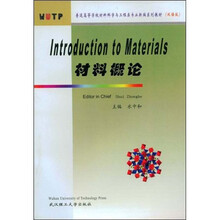双语版普通高等学校材料科学与工程类专业新编系列教材 :材料概论

1 Introduction to Materials
1.1 Materials and Materials Science
1.1.1 How Is Materials Defined
1.1.2 The Three Classes of Materials
1.1.3 Materials Properties
1.1.4 Use of Materials
1.1.5 Materials Science
1.2 Types of Materials
1.2.1 Metal
1.2.2 Ceramics and Glasses
1.2.3 Polymers
1.2.4 Composites
1.3 Structural Characteristic of Materials
1.3.1 Crystal Lattice
1.3.2 Crystallographic Indices
1.3.3 Anisotropy
1.4 Structure-property-processing Interaction
1.4.1 properties
1.4.2 Structure
1.4.3 Processing
1.4.4 Structure-property-processing Interaction
Questions and Problems
References
2 Metallic Materials
2.1 Metals
2.2 Ferrous Metals
2.2.1 Ferrous Metals Group
2.2.2 Production of Iron
2.2.3 Production of Steel
2.2.4 Cast Iron Alloys
2.2.5 Steels
2.3 Nonferrous Metals
2.3.1 Introduction
2.3.2 Nonferrous Metals in Common Use
2.3.3 Titanium,Nickel,and Cobalt
2.3.4 Other Nonferrous Metals
2.4 The Physical and Mechanical Properties of Metals
2.4.1 Mechanical Properties
2.4.2 Metals at Low Temperatures
2.4.3 Physical Properties
2.5 The Crystal Structure of Metals
2.5.1 Bonding of Metals
2.5.2 Metals and Nonmetals
2.5.3 Crystalline Unit Structures
2.6 Corrosion
Questions and Problems
References
3 Ceramic Materials
3.1 Introduction
3.2 Nature of Ceramics
3.2.1 Porosity of Ceramics
3.2.2 Structure of Ceramics
3.2.3 Ceramics Phase Diagrams
3.3 Ceramics Processing
3.3.1 Traditional Processing
3.3.2 Advanced Ceramic Processing
3.4 Properties of Ceramics
3.4.1 Mechanical Properties
3.4.2 Physical Properties
3.4.3 Chemical Proterties
3.4.4 Fabricability
3.4.5 Other Properties
3.4.6 Designing Ceramics
3.5 Application of Ceramics
Questions and Problems
References
4 The Glass Sciences
4.1 The World of Glasses
4.1.1 Natural Glasses
4.1.2 Glass in Modem Tirues
4.1.3 Different Types ofGlasses
4.2 Preparation Technologies of Glasses
4.2.1 Preparation ofGlasses
4.2.2 Microwave Heating in Glass Preparation
4.2.3 Sol-gel Process
4.2.4 Chemical Nature of Glass Forming Materials
4.2.5 Stru&ural Approach to Glass Formation
4.3 Structures and Properties of Glasses
4.3.1 Continuous RandOm Network Model
4.3.2 Random Close Packing Model
4.3.3 Bonding Tlheories
4.3.4 Kinetic Criteria for Glass Formation
4.3.5 Thermal Behaviour ofGlasses
4.3.6 Physical Properties
4.3.7 Optical Properties
4.3.8 Chemical Stability
4.3.9 Electrical Nature ofGlass
4.4 Applications of Glasses
4.4.1 Glass Products
4.4.2 Architectural GIass
4.4.3 Anti.solar Glass
4.4.4 Zero-expansion Transparent Glass Ceramics
4.4.5 Glass for Active-matrix Liquid-crystal Display Panels
4.4.6 Fibre Optics
4.4.7 Fine Particulates and Nano—glasses
4.5 Recent Topics of Optoelectronics Materials
4.5.1 Blue and Green Light Sources
4.5.2 Optical Switches
4.5.3 Optical Fibers
Questions and Problems
5 Cement and Concrete Materials
5.1 Pbrtland Cement and Its Major Constituent Phases
5.1.1 Portland Cement General
5.1.2 Types ofPortland Cement
5.1.3 Cement Chemical Nomenclature and Other Abbreviations
5.2 Getting Acquainted with Concrete
5.2.1 Properties Desired in Fresh or Plastic Concrete
5.2.2 Properties Desired in Hardened Concrete
5.2.3 Properties ofConcrete
5.2.4 Variables That Influence Concrete Quality
5.2.5 Consumer Product Safety
5.3 Concrete:Strength and Behavior
5.3.1 Introduction
5.3.2 Uniaxial Behavior
5.3.3 Tension Strength
5.4 Uses of Concrete
5.4.1 Reinforeed Concrete
5.4.2 Prestressed Concrete
5.4.3 Preeast Concrete
5.4.4 Lightweight Concrete
5.4.5Thin Shell
5.4.6 Shotcrete
5.4.7 Construction witll Prefabricated Concrete Units
5.5 New Type of Cement.based Materials
5.5.1 General
5.5.2 DSP Concretes
5.5.3 MDF Cements
Questions and Problems
References
6 POlymer Materials
6.1 Polymer and Nomenclature
6.1.1 Nomenclature Based on Source
6.1.2 Nomenclature Based on Structure(Non-IUPAC)
6.1.3 IUPAC Structure.based Nomenclature System
6.1.4 Trade Names and Nonnames
6.2 P0lymer Synthesis
6.3 Structure—property Relations
6.3.1 General consideration
6.3.2 Control of T and Tm
6.3.3 Relation between T and Tm
6.4 Mechanical Properties of Elastomers,Fibers,and Plastics
6.4.1 Mechanical Properties
6.4.2 Elastomers,Fibets,and Plastics
6.5 Polymeric Biomaterials for Tissue and Organ Regeneration
Questions and Problems
References
7 Composite Materials
7.1 An Overview of Composites
7.1.1 Introduction
7.1.2 Definition of Composites
7.1.3 Materials ofConstruction
7.2 Surface Treatment of Reinforcing Materials
7.2.1 Cost Factor
7.2.2 Chemistry 0fSutrace Treatment and Interfacial Structure
7.3 Mechanical Property of Polymeric Composite
7.3.1 Introduction
7.3.2 Polymer Matrix Composites
7.4 Smart Structural Composites
7.4.1 Cement-marx Composites
7.4.2 Polymer-matrix Composites
7.5 Framework for Nanoeomposites
Questions and Problems
Befemnces
1.1 Materials and Materials Science
1.1.1 How Is Materials Defined
1.1.2 The Three Classes of Materials
1.1.3 Materials Properties
1.1.4 Use of Materials
1.1.5 Materials Science
1.2 Types of Materials
1.2.1 Metal
1.2.2 Ceramics and Glasses
1.2.3 Polymers
1.2.4 Composites
1.3 Structural Characteristic of Materials
1.3.1 Crystal Lattice
1.3.2 Crystallographic Indices
1.3.3 Anisotropy
1.4 Structure-property-processing Interaction
1.4.1 properties
1.4.2 Structure
1.4.3 Processing
1.4.4 Structure-property-processing Interaction
Questions and Problems
References
2 Metallic Materials
2.1 Metals
2.2 Ferrous Metals
2.2.1 Ferrous Metals Group
2.2.2 Production of Iron
2.2.3 Production of Steel
2.2.4 Cast Iron Alloys
2.2.5 Steels
2.3 Nonferrous Metals
2.3.1 Introduction
2.3.2 Nonferrous Metals in Common Use
2.3.3 Titanium,Nickel,and Cobalt
2.3.4 Other Nonferrous Metals
2.4 The Physical and Mechanical Properties of Metals
2.4.1 Mechanical Properties
2.4.2 Metals at Low Temperatures
2.4.3 Physical Properties
2.5 The Crystal Structure of Metals
2.5.1 Bonding of Metals
2.5.2 Metals and Nonmetals
2.5.3 Crystalline Unit Structures
2.6 Corrosion
Questions and Problems
References
3 Ceramic Materials
3.1 Introduction
3.2 Nature of Ceramics
3.2.1 Porosity of Ceramics
3.2.2 Structure of Ceramics
3.2.3 Ceramics Phase Diagrams
3.3 Ceramics Processing
3.3.1 Traditional Processing
3.3.2 Advanced Ceramic Processing
3.4 Properties of Ceramics
3.4.1 Mechanical Properties
3.4.2 Physical Properties
3.4.3 Chemical Proterties
3.4.4 Fabricability
3.4.5 Other Properties
3.4.6 Designing Ceramics
3.5 Application of Ceramics
Questions and Problems
References
4 The Glass Sciences
4.1 The World of Glasses
4.1.1 Natural Glasses
4.1.2 Glass in Modem Tirues
4.1.3 Different Types ofGlasses
4.2 Preparation Technologies of Glasses
4.2.1 Preparation ofGlasses
4.2.2 Microwave Heating in Glass Preparation
4.2.3 Sol-gel Process
4.2.4 Chemical Nature of Glass Forming Materials
4.2.5 Stru&ural Approach to Glass Formation
4.3 Structures and Properties of Glasses
4.3.1 Continuous RandOm Network Model
4.3.2 Random Close Packing Model
4.3.3 Bonding Tlheories
4.3.4 Kinetic Criteria for Glass Formation
4.3.5 Thermal Behaviour ofGlasses
4.3.6 Physical Properties
4.3.7 Optical Properties
4.3.8 Chemical Stability
4.3.9 Electrical Nature ofGlass
4.4 Applications of Glasses
4.4.1 Glass Products
4.4.2 Architectural GIass
4.4.3 Anti.solar Glass
4.4.4 Zero-expansion Transparent Glass Ceramics
4.4.5 Glass for Active-matrix Liquid-crystal Display Panels
4.4.6 Fibre Optics
4.4.7 Fine Particulates and Nano—glasses
4.5 Recent Topics of Optoelectronics Materials
4.5.1 Blue and Green Light Sources
4.5.2 Optical Switches
4.5.3 Optical Fibers
Questions and Problems
5 Cement and Concrete Materials
5.1 Pbrtland Cement and Its Major Constituent Phases
5.1.1 Portland Cement General
5.1.2 Types ofPortland Cement
5.1.3 Cement Chemical Nomenclature and Other Abbreviations
5.2 Getting Acquainted with Concrete
5.2.1 Properties Desired in Fresh or Plastic Concrete
5.2.2 Properties Desired in Hardened Concrete
5.2.3 Properties ofConcrete
5.2.4 Variables That Influence Concrete Quality
5.2.5 Consumer Product Safety
5.3 Concrete:Strength and Behavior
5.3.1 Introduction
5.3.2 Uniaxial Behavior
5.3.3 Tension Strength
5.4 Uses of Concrete
5.4.1 Reinforeed Concrete
5.4.2 Prestressed Concrete
5.4.3 Preeast Concrete
5.4.4 Lightweight Concrete
5.4.5Thin Shell
5.4.6 Shotcrete
5.4.7 Construction witll Prefabricated Concrete Units
5.5 New Type of Cement.based Materials
5.5.1 General
5.5.2 DSP Concretes
5.5.3 MDF Cements
Questions and Problems
References
6 POlymer Materials
6.1 Polymer and Nomenclature
6.1.1 Nomenclature Based on Source
6.1.2 Nomenclature Based on Structure(Non-IUPAC)
6.1.3 IUPAC Structure.based Nomenclature System
6.1.4 Trade Names and Nonnames
6.2 P0lymer Synthesis
6.3 Structure—property Relations
6.3.1 General consideration
6.3.2 Control of T and Tm
6.3.3 Relation between T and Tm
6.4 Mechanical Properties of Elastomers,Fibers,and Plastics
6.4.1 Mechanical Properties
6.4.2 Elastomers,Fibets,and Plastics
6.5 Polymeric Biomaterials for Tissue and Organ Regeneration
Questions and Problems
References
7 Composite Materials
7.1 An Overview of Composites
7.1.1 Introduction
7.1.2 Definition of Composites
7.1.3 Materials ofConstruction
7.2 Surface Treatment of Reinforcing Materials
7.2.1 Cost Factor
7.2.2 Chemistry 0fSutrace Treatment and Interfacial Structure
7.3 Mechanical Property of Polymeric Composite
7.3.1 Introduction
7.3.2 Polymer Matrix Composites
7.4 Smart Structural Composites
7.4.1 Cement-marx Composites
7.4.2 Polymer-matrix Composites
7.5 Framework for Nanoeomposites
Questions and Problems
Befemnces
水中和,男,武汉理工大学材料科学与工程学院教授、博士生导师。曾先后获得原武汉建材学院和武汉工业大学(现武汉理工大学)学士和硕士学位。多年从事材料科学与工程的教学和科研工作。1996年9月赴荷兰代尔夫特理工大学(Dem university of Technology)土木与地球科学学院进修并攻读博士学位,2001年1月获该校博士学位。2001年6月至2002年6月任香港理工大学土木与结构工程系助理研究员,主要研究领域为生态建筑材料、水泥基复合材料、混凝土材料与结构的检测与评价。
《材料概论》是普通高等学校材料科学与工程专业类“材料概论”或相关课程的双语教材。全书以国外著名的材料科学与工程著作和综述性论文为基础,以材料“结构-制备-性能-应用”为主线,系统介绍了材料科学与工程的基本知识、基本原理以及材料的应用技术。
全书共分七章,分别涉及材料科学基本知识、金属材料、陶瓷材料、玻璃材料、水泥混凝土材料、高分子材料和复合材料的有关内容。每一章由若干小节组成,每节又分为基本课文和阅读材料。在基本课文后附有部分专业词汇和注释,阅读材料中的疑难点在课文中加以注释。师生们在教学过程中可选择使用。
《材料概论》也可供从事材料研究与应用的人员作为了解专业知识、提高英语水平的阅读材料。
全书共分七章,分别涉及材料科学基本知识、金属材料、陶瓷材料、玻璃材料、水泥混凝土材料、高分子材料和复合材料的有关内容。每一章由若干小节组成,每节又分为基本课文和阅读材料。在基本课文后附有部分专业词汇和注释,阅读材料中的疑难点在课文中加以注释。师生们在教学过程中可选择使用。
《材料概论》也可供从事材料研究与应用的人员作为了解专业知识、提高英语水平的阅读材料。
比价列表
公众号、微信群
 缺书网
缺书网微信公众号
 扫码进群
扫码进群实时获取购书优惠






